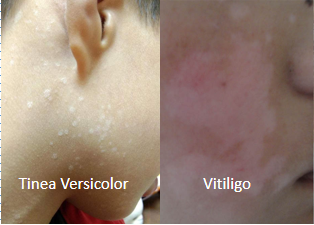The Difference Between Vitiligo and Tinea Versicolor

Tinea versicolor, also known as pityriasis versicolor, is a skin condition that can be easily confused with vitiligo, especially in the early stages when the symptoms of vitiligo are not particularly obvious and can be easily misdiagnosed.
So what is tinea versicolor? Tinea versicolor is a skin disease caused by a fungus, the skin damage is predominantly pale white, and most of its lesions are round or oval spots with blurred edges. The surface of tinea versicolor often has many microscopic scales, so it is also called furfuracea. The patient's skin surface is refractive, and the fungus can be found directly by microscopic examination. Tinea versicolor is mostly seen in young people and mainly appears in sebaceous gland developed parts, such as the upper parts of the body such chest, back, and neck.
Vitiligo is an acquired skin disease, which is not caused by fungus but the loss of melanin pigment results in the formation of white patches, you can not find the fungus under the microscope. Vitiligo symptoms are usually not self-conscious symptoms, after a long time of exposure to strong sunlight, it easily appears to be red, and even causes blisters, and burning pain. After inflammation, the white spots can become larger than the primary area, the lesions can occur in any part but are more common in the back of the fingers, wrists, forearms, face and neck, genitalia, and their surroundings. If the skin is completely depigmented, the patches would appear to be porcelain white. The size of patches varies, the boundary would be clear if is in the stable stage. The edges of patches could have pigmentation. And the surface of the patches has no scales, sweating too much will not aggravate it as in tinea versicolor.
The correct distinction between vitiligo and tinea versicolor is an important element of the diagnosis of vitiligo and is the basis for correct and effective treatment. The most important thing in this passage is that you should not confuse vitiligo and tinea versicular to avoid aggravating or delaying the treatment of vitiligo.



Leave a Comment